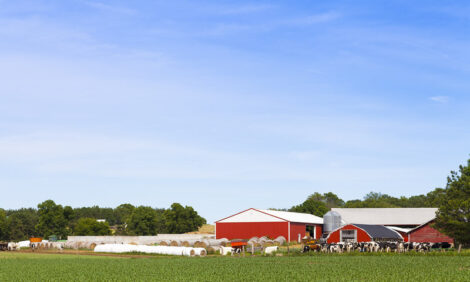



Effects of Dystocia on Subsequent Performance in Dairy Cows
Researchers for TEAGASC have found that dystocia significantly impacts on milk production and reproductive performance. Building on recent work by academics such as D.P Berry and J.M Mee the report sampled over 2 million calving events since 2002 and indicates the economic significance of dystocia to the profitability of Irish farms.Introduction
Dystocia is defined as a calving that requires more assistance than desirable (Meijering, 1984). Dystocia is an economically important trait in the dairy industry as it is associated with approximately 50% of calf mortality cases at birth (Mee et al., 2008; Purfield et al., 2012) but can also have a profound influence on cow performance postpartum. The objective of this study was to quantify the effect of calving dystocia on subsequent cow fertility, milk production, and survival in Irish dairy herds.
Materials and Methods
Calving dates from 972,820 cows totalling 2,034,846 calving events between the years 2002 and 2010 were
available from 16,413 dairy herds. Calving to first service interval (CFS) was calculated as the number of
days from calving to first recorded service; only calving to first service intervals of between 10 and 250 days
were retained.
Number of serves (NS) was calculated as the number of inseminations per cow during the
breeding season. Only calving intervals (CIV) between 300 and 800 days were retained. Survival (SURV)
was defined as whether a cow survived from one lactation to the next.
A cow was assumed not to have
survived to a subsequent lactation if:
1) no calving record was available for the following lactation
2) the
difference between the cow’s last recorded calving date was greater than 800 days from the last recorded
calving date of the herd
3) if the cow was slaughtered or died on farm within 400 days of calving.
Cows
that were recorded as died in the first 50 days (DEAD50) post calving were coded separately. Culling
information was available from the cattle movement monitoring system (CMMS) data. In Ireland calving
difficulty is scored on a scale of 1 to 4 as follows: no assistance/unobserved; slight assistance; severe
assistance or veterinary assistance.
In the present study dystocia was defined as severe or veterinary
assistance. Only herds that recorded some level of dystocia (1 to 10%) were retained. Average milk yield in
the first 60 days post-calving as well as mean milk fat and protein percentage was predicted from a
smoothing spline fitted, within lactation, to test-day records using seven knot points.
Cows calving less than
or greater than 22 months from the median age within parity were excluded from the analysis. Only calving
events from parity one to five were retained and herds with no recorded fertility information were discarded.
Contemporary group was defined as herd-year-season of calving; only contemporary groups with at least 5
records were retained.
Following all edits 65,535 animals remained. The effects of dystocia on subsequent
cow performance were determined using a mixed model (ASReml; Gilmour et al, 2011).
Fixed effects were
parity, age (in months) relative to the median age within parity, the proportion of Holstein and Friesian in
each cow, heterosis and recombination loss regression coefficients, dystocia (yes/no) and contemporary
group. Cow was included as a random effect.
Results and Discussion
The incidence of dystocia recorded in the present study was 5.15% which is in line with the previously
documented dystocia incidence in Ireland (Mee et al., 2008; Mee et al., 2011). The effects of dystocia on
fertility, survival and production are summarised in Table 1. The average CFS, CIV and NS were 75.7 d, 397
d and 1.7 serves, respectively. The proportion of cows that survived to the next lactation was 85% and the
proportion of cows that died during the first 50 d post partum was 0.6%.
Cows that experienced dystocia had a longer interval to first service which is likely due to a delayed
resumption of cyclicity post-calving. Cows that experienced dystocia also required more inseminations and
therefore also had longer calving intervals. The probability of the cow surviving to subsequent lactation was
also reduced for cows that experienced dystocia (-0.08) compared to cows with no dystocia. The average
reduction in milk yield across the first 60 days in milk (-36.13 kg) for cows that experienced dystocia at
calving was consistent with a previous study in New Zealand (-42.0 kg; Berry et al., 2007). Similarly fat (-1.58
kg) and protein (-1.18 kg) yield were also reduced in cows that experienced dystocia at calving.
| Regression Coefficients (b; Standard Error in Parenthesis) on the Effect of Dystocia on Cow Performance (P <0.01)a | ||
|---|---|---|
| Performance | Trait | b (s.e.) |
| Fertility | CFS (days) | 0.74 (1.10) |
| NS (number) | 0.16 (0.04) | |
| CIV(days) | 21.56 (1.32) | |
| Survival | SURV (%) | -0.08 (0.01) |
| DEAD 50d (%) | 0.01 (0.002) | |
| Production | Milk yield (kg) | -36.13 (21.07) |
| Fat yield (kg) | -1.58 (0.88) | |
| Protein yield (kg) | -1.18 (0.69) | |
Conclusions
Results from this study clearly show that calving dystocia reduces (P<0.01) milk production, reproductive performance and cow survival and can consequently reduce farm profitability on dairy farms.
References
Berry, D.P. Lee, J.M. Macdonald, K.A., & Roche, J.R. (2007) J. Dairy Sci. 90:4201-4211.
Gilmour, A.R., Cullis, B.R., Welham, S.J., & Thompson, R. (2011). ASREML Reference Manual.
Mee, J.F., Berry, D.P., & Cromie, A.R. (2008). Animal 2:613-620.
Mee, J.F., Berry, D.P., & A.R. Cromie (2011). Vet. J. 187:189-194.
Meijering, A. (1984). Livest. Prod. Sci. 11:143-177.
Purfield, D., Bradley, D.G., Kearney, J.F., & Berry, D.P. (2012). Proc .Agric. Res. Forum. (In press).
November 2012


